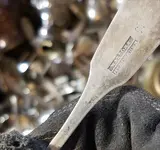UnderMiner
Silver Member
- Joined
- Jul 27, 2014
- Messages
- 3,976
- Reaction score
- 10,466
- Golden Thread
- 2
- Location
- New York City
- 🥇 Banner finds
- 2
- Detector(s) used
- Minelab Excalibur II, Equinox 800
- Primary Interest:
- All Treasure Hunting
- #1
Thread Owner
So I found roughly 4.5+ pounds of 1800's silver treasure about two months ago. I wanted to post it to 'today's finds' the day I found it but it took me so long to document and research the whole thing that weeks had past by the time I was done. The histories behind many of the 72 pieces of treasure contained in the hoard are very fascinating. The oldest two spoons are from 1801 - the Napoleonic and Regency age - while King George III was still in power. The latest silver spoon in the hoard is inscribed with the date 1911 - when King George V was in his first full year of power - the year prior to the Titanic disaster. I pulled all of this treasure out of a dumpster - piece by meticulous piece. The house had been recently sold to new owners and they were throwing everything inside it into the trash. The previous owner must have collected silver spoons and the new owners must have been oblivious to the fact that silver spoons are valuable, so the treasure is mine now. I estimate it's worth at minimum $1,000.
I put all the treasure into a planter pot as I was digging it out:
In this first pic I am holding a Cartier sterling silver shot glass made in the style of the thimble, it was one of the few non-spoon treasures.
It was made in 1965 and is most modern treasure in the hoard.
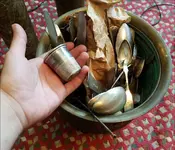
The majority of the silver spoons are American coin silver and date from the 1800's-1860's.
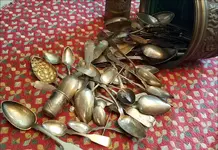
This is an image of the silver on a scale, note the weight in lbs. I tared out the container holding the silver so what you see is the true weight of only the solid silver items.
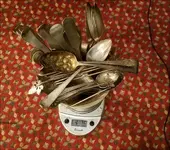
In the hoard were two Russian Imperial silver serving spoons, both from 1875. Made in the city of Kamenetz-Podolsk of the Russian Empire in what is today part of Western Ukraine. The Czar at this time was Alexander II. 8 years prior to the making of these spoons, Czar Alexander II sold Alaska to former Lincoln Secretary of State William H. Seward for $7.2 million, a move that made the US population ridicule him calling the move "Seward's Folly" little did they know that Alaska was rich in minerals like gold and oil which would benefit the US greatly well into the modern age.

This set of three Sterling silver spoons includes one spoon with an inscription from 1911. The spoons were likely given as trophy prize for a tennis competition. I found only three, but it's likely the original set would have been at least six or perhaps even twelve, but those spoons have been lost to time:
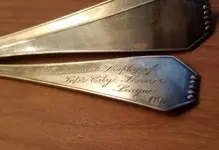
These are the best find of all of the spoons.
They are a matched set of 1801 London George III 'Berry spoons'.
They are sterling with gold washed bowls over a 3-dimensional berry motif.
The scroll work on the handle is most likely a later addition from Victorian times.
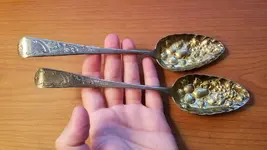
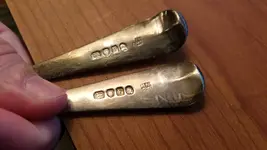
A familiar face, the crowned leopard's head. It was used to hallmark Sterling in Britain from the 14th century until 1821. In 1821 there was a clerical error in the official silver hallmarking law that accidentally omitted the fact that the leopard's head had to be wearing a crown, the silver industry thus followed the law as it was written and omitted the crown. Thee leopard's head would remain uncrowned on British sterling to this day.
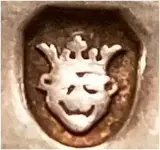
The bust of King George III himself! Some current events that were happening when this mark was impressed into this silver: Thomas Jefferson was sworn in as the 3rd US president. Napoleon loses the Siege of Cairo to British forces. Tripoli declares war on the USA following American disapproval of the Barbary Pirates and the First Barbary War begins. The first census is held in Great Britain. The population of England and Wales is determined to be 8.9 million, with London revealed to have 860,035 residents.
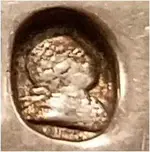
This is a picture of most of the treasure, I went back to the dumpster the next day and found a few more pieces. The long silver things on top are sterling silver straws:
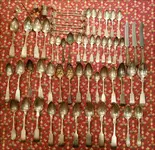
In total there were 72 pieces of silver treasure including 50 silver spoons. Three spoons were of European origin made from 13 Loth or 81% silver, two spoons were Russian 84 Zolotnik or 87.5% silver and dated from 1875, two spoons were British Sterling from 1801, three spoons were Sterling from 1911, the other spoons were all 1800's American coin silver - 90% pure from various manufacturers - there were three complete sets and many one-off spoons, far too many to document in one post here. I suspect a few of the one-off American coin silver spoons are from the late 1700's as their styles are more similar to this earlier time period. I have yet to fully document all of the manufacturers of these American coin silver spoons.
I put all the treasure into a planter pot as I was digging it out:
In this first pic I am holding a Cartier sterling silver shot glass made in the style of the thimble, it was one of the few non-spoon treasures.
It was made in 1965 and is most modern treasure in the hoard.

The majority of the silver spoons are American coin silver and date from the 1800's-1860's.

This is an image of the silver on a scale, note the weight in lbs. I tared out the container holding the silver so what you see is the true weight of only the solid silver items.

In the hoard were two Russian Imperial silver serving spoons, both from 1875. Made in the city of Kamenetz-Podolsk of the Russian Empire in what is today part of Western Ukraine. The Czar at this time was Alexander II. 8 years prior to the making of these spoons, Czar Alexander II sold Alaska to former Lincoln Secretary of State William H. Seward for $7.2 million, a move that made the US population ridicule him calling the move "Seward's Folly" little did they know that Alaska was rich in minerals like gold and oil which would benefit the US greatly well into the modern age.

This set of three Sterling silver spoons includes one spoon with an inscription from 1911. The spoons were likely given as trophy prize for a tennis competition. I found only three, but it's likely the original set would have been at least six or perhaps even twelve, but those spoons have been lost to time:

These are the best find of all of the spoons.
They are a matched set of 1801 London George III 'Berry spoons'.
They are sterling with gold washed bowls over a 3-dimensional berry motif.
The scroll work on the handle is most likely a later addition from Victorian times.


A familiar face, the crowned leopard's head. It was used to hallmark Sterling in Britain from the 14th century until 1821. In 1821 there was a clerical error in the official silver hallmarking law that accidentally omitted the fact that the leopard's head had to be wearing a crown, the silver industry thus followed the law as it was written and omitted the crown. Thee leopard's head would remain uncrowned on British sterling to this day.

The bust of King George III himself! Some current events that were happening when this mark was impressed into this silver: Thomas Jefferson was sworn in as the 3rd US president. Napoleon loses the Siege of Cairo to British forces. Tripoli declares war on the USA following American disapproval of the Barbary Pirates and the First Barbary War begins. The first census is held in Great Britain. The population of England and Wales is determined to be 8.9 million, with London revealed to have 860,035 residents.

This is a picture of most of the treasure, I went back to the dumpster the next day and found a few more pieces. The long silver things on top are sterling silver straws:

In total there were 72 pieces of silver treasure including 50 silver spoons. Three spoons were of European origin made from 13 Loth or 81% silver, two spoons were Russian 84 Zolotnik or 87.5% silver and dated from 1875, two spoons were British Sterling from 1801, three spoons were Sterling from 1911, the other spoons were all 1800's American coin silver - 90% pure from various manufacturers - there were three complete sets and many one-off spoons, far too many to document in one post here. I suspect a few of the one-off American coin silver spoons are from the late 1700's as their styles are more similar to this earlier time period. I have yet to fully document all of the manufacturers of these American coin silver spoons.




